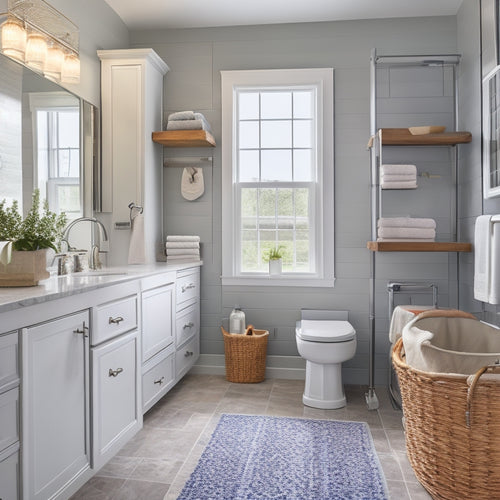
Boost Profits With Energy-Efficient Restaurant Practices
Share
By adopting energy-efficient practices, restaurants can greatly reduce energy consumption and operating costs, leading to increased profitability. Implementing measures such as energy audits, water conservation, and smart equipment choices can save up to 30% on energy bills. Additionally, energy-efficient lighting and optimized heating and cooling systems can further decrease energy costs. Waste reduction strategies, such as composting and donation programs, can also contribute to a more sustainable future. By prioritizing energy efficiency, restaurants can not only boost their bottom line but also minimize their environmental footprint. Discover the specific strategies that can help your restaurant thrive while making a positive impact.
Key Takeaways
• Conduct energy audits to identify areas of improvement and prioritize water conservation efforts to reduce utility bills.
• Install low-flow fixtures and greywater reuse systems, and utilize ENERGY STAR certified products and WaterSense program for long-term savings.
• Adopt energy-efficient lighting solutions, such as LEDs, to reduce energy consumption and improve light quality while cutting costs.
• Optimize heating and cooling systems through regular maintenance, programmable thermostats, and zoned temperature regulation to minimize energy waste.
• Implement waste reduction strategies, including efficient food purchasing, donation programs, and composting initiatives, to reduce environmental impact and boost profits.
Energy Efficiency Essentials
Implementing energy-efficient practices in restaurants is essential, as the commercial food service industry alone accounts for approximately 2% of the total energy consumption in the United States, with opportunities for significant cost savings and environmental benefits.
Conducting energy audits can help identify areas of improvement, allowing restaurants to prioritize energy-saving initiatives. Water conservation is also critical, as restaurants use an average of 50,000 gallons of water per year.
By implementing low-flow fixtures and greywater reuse systems, restaurants can reduce their water footprint. Additionally, restaurants can take advantage of ENERGY STAR certified products and the EPA's WaterSense program to identify water-efficient products.
Smart Equipment Choices
Upgrading to energy-efficient equipment can yield significant savings, with ENERGY STAR certified products offering reductions in energy consumption of up to 70% compared to standard models. By making smart equipment choices, restaurants can reduce their environmental footprint while also boosting their bottom line. Here are some key considerations for smart investing in equipment upgrades:
-
Assess Your Current Equipment: Identify areas where energy-efficient upgrades can make the biggest impact.
-
Research ENERGY STAR Certified Products: Look for products that meet energy efficiency standards set by the EPA.
-
Consider the Total Cost of Ownership: Factor in long-term energy savings when evaluating equipment costs.
- Plan for Regular Maintenance: Make sure that new equipment is properly maintained to maximize its energy efficiency.
Lighting for Savings
Lighting, which accounts for approximately 13% of a restaurant's total energy consumption, presents a notable opportunity for energy and cost savings through the adoption of energy-efficient lighting solutions. Lighting upgrades can make a substantial impact on a restaurant's bottom line.
By replacing traditional lighting with energy-saving bulbs, restaurants can reduce energy consumption by up to 90%. LEDs, for instance, consume considerably less energy than traditional lighting options. Additionally, energy-efficient lighting products offer exceptional features such as longer lifetimes and improved light quality.
Heating and Cooling Smarts
With energy-efficient lighting solutions in place, restaurants can shift their focus to optimizing their heating and cooling systems, which account for nearly 28% of their total energy consumption. By implementing smart heating and cooling practices, restaurants can greatly reduce their energy costs and environmental impact.
Here are some strategies to explore:
-
Regular HVAC maintenance: Make sure your heating, ventilation, and air conditioning (HVAC) system is running efficiently by scheduling regular tune-ups and filter changes.
-
Thermostat programming: Install programmable thermostats to regulate temperature settings and optimize energy use during peak and off-peak hours.
-
Zoning systems: Divide your restaurant into zones to heat or cool only occupied areas, reducing energy waste.
- Energy-efficient HVAC equipment: Consider upgrading to ENERGY STAR certified HVAC equipment, which can save you money on energy costs annually.
Waste Reduction Strategies
By implementing efficient waste reduction strategies, restaurants can greatly decrease their environmental footprint and save resources, as the US alone generates over 36 million tons of food waste annually.
Simple changes in food purchasing and preparation can markedly reduce waste. Restaurants can participate in donation programs, donating excess food to food banks and helping those in need.
Composting initiatives can also be implemented, recycling food scraps into nutrient-rich soil for agricultural use. By adopting these strategies, restaurants can reduce their environmental impact, conserve resources, and contribute to a more sustainable future.
Frequently Asked Questions
How Can Energy-Efficient Practices Impact a Restaurant's Brand Reputation?
By adopting energy-efficient practices, restaurants can enhance their brand reputation by demonstrating a commitment to sustainability, fostering brand loyalty, and positively influencing customer perception, ultimately driving business growth and community appreciation.
Are There Government Incentives for Energy-Efficient Restaurant Upgrades?
Like a puzzle piece falling into place, government incentives align with energy-efficient upgrades, offering tax credits and grant opportunities to restaurants, fostering a sustainable reputation and bottom-line benefits, while reducing environmental footprint.
Can Energy-Efficient Equipment Be Integrated With Existing Systems?
When integrating energy-efficient equipment with existing systems, consider system upgrades that leverage vendor partnerships to guarantee seamless compatibility, minimizing disruptions and maximizing ROI, while reducing environmental footprint and enhancing operational efficiency.
How Do Energy-Efficient Practices Affect Food Quality and Safety?
Implementing energy-efficient practices in restaurants does not compromise food quality and safety, as precise temperature control guarantees consistent results, while sustainable supply chain management reduces environmental impact, fostering a sense of community and social responsibility.
What Is the Average ROI for Energy-Efficient Restaurant Upgrades?
The average ROI for energy-efficient restaurant upgrades varies, but financial projections suggest cost savings of 10-70% can be achieved, resulting in a significant return on investment, with some upgrades paying for themselves in as little as 1-2 years.
Related Posts
-

Modern Vanity Units With Storage Options
Modern vanity units with storage options transform your bathroom into a stylish and organized haven. These vanities b...
-

Transform Your Bathroom With Clever Storage Hacks
Elevate your bathroom's functionality and style with clever storage hacks. Maximize space by utilizing the back of th...
-

Empowerment and Opportunities at USC JEP
The University of Southern California's Joint Educational Project (JEP) offers a wide range of empowerment and opport...


